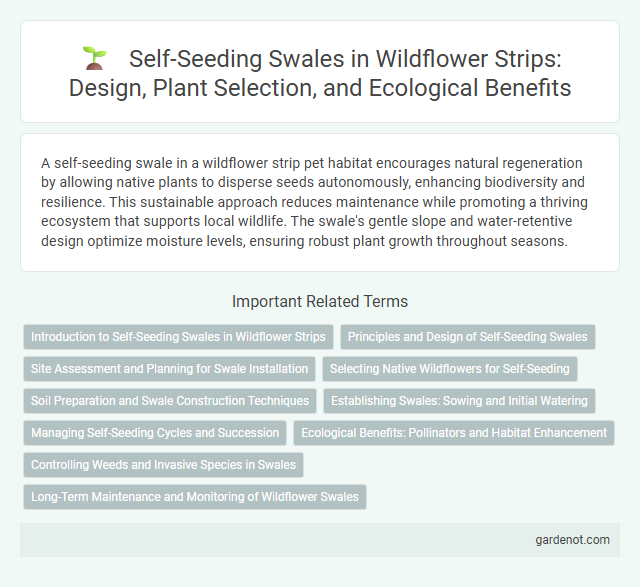A self-seeding swale in a wildflower strip pet habitat encourages natural regeneration by allowing native plants to disperse seeds autonomously, enhancing biodiversity and resilience. This sustainable approach reduces maintenance while promoting a thriving ecosystem that supports local wildlife. The swale's gentle slope and water-retentive design optimize moisture levels, ensuring robust plant growth throughout seasons.
Introduction to Self-Seeding Swales in Wildflower Strips
Self-seeding swales in wildflower strips are natural drainage channels designed to capture and filter stormwater runoff while promoting biodiversity through native plant regeneration. These swales leverage native wildflowers' ability to self-seed, reducing maintenance and supporting pollinators like bees and butterflies. Incorporating self-seeding swales enhances ecosystem services, improves soil health, and contributes to sustainable urban and agricultural landscapes.
Principles and Design of Self-Seeding Swales
Self-seeding swales harness natural seed dispersal and soil conditions to promote sustainable vegetation growth, reducing maintenance and enhancing biodiversity. Key principles include proper grading to facilitate water infiltration, selecting native wildflower species adapted to local climate, and ensuring minimal soil disturbance for optimal seed germination. Effective design incorporates slope control, erosion prevention measures, and strategic placement to maximize water retention and support diverse plant communities within the swale ecosystem.
Site Assessment and Planning for Swale Installation
Site assessment for self-seeding swale installation involves analyzing soil permeability, slope gradient, and existing vegetation to ensure optimal water infiltration and erosion control. Planning includes selecting native wildflower species adapted to local climate conditions and designing swale dimensions to manage runoff volume effectively. Proper evaluation of hydrological patterns and soil characteristics promotes sustainable establishment and maintenance of the swale ecosystem.
Selecting Native Wildflowers for Self-Seeding
Selecting native wildflowers for a self-seeding swale enhances soil stabilization and supports local pollinators by ensuring plant adaptability to regional climate and soil conditions. Species such as Echinacea purpurea, Solidago canadensis, and Asclepias tuberosa thrive in swale environments, providing continuous bloom cycles and seed dispersal without ongoing maintenance. Prioritizing native varieties reduces invasive risks, promotes biodiversity, and fosters resilient ecosystems within wildflower strips.
Soil Preparation and Swale Construction Techniques
Proper soil preparation for a self-seeding swale involves loosening the soil to a depth of 12-18 inches to enhance water infiltration and root penetration. Construction techniques include shaping a gently sloped swale bed with berms on the downslope side to capture runoff, using natural contours to guide water flow and prevent erosion. Incorporating organic matter and native wildflower seed mixes during soil preparation promotes sustainable growth and ecosystem resilience.
Establishing Swales: Sowing and Initial Watering
Establishing swales requires precise sowing of native, drought-resistant wildflower seeds tailored for self-seeding swale ecosystems. Proper initial watering techniques ensure deep soil moisture, promoting vigorous seed germination and root establishment essential for long-term swale health. Maintaining optimal soil conditions during the first growth phase accelerates swale development, enhancing water retention and biodiversity.
Managing Self-Seeding Cycles and Succession
Managing self-seeding cycles in wildflower swales involves monitoring seed dispersion and establishing periodic disturbances like mowing or selective weeding to prevent dominant species from overtaking the habitat. Encouraging natural succession through controlled interventions promotes biodiversity by allowing different wildflower species to emerge and maintain ecological balance. Effective management ensures continuous regeneration and sustained wildflower diversity within the swale ecosystem.
Ecological Benefits: Pollinators and Habitat Enhancement
Self-seeding swales in wildflower strips provide critical ecological benefits by supporting diverse pollinator species, including bees, butterflies, and hoverflies, which are essential for ecosystem health and crop productivity. These swales enhance habitat complexity by offering nectar, pollen, and shelter, promoting biodiversity and fostering resilient urban and agricultural landscapes. Incorporating native wildflowers in self-seeding swales significantly improves habitat connectivity and sustains pollinator populations year-round.
Controlling Weeds and Invasive Species in Swales
Self-seeding swale designs effectively suppress weeds and invasive species by promoting dense native wildflower growth, which creates natural competition and reduces open soil patches. Integrating species with rapid germination and ground cover traits minimizes weed establishment and soil erosion. Regular monitoring and strategic selective removal ensure native dominance and swale ecosystem stability.
Long-Term Maintenance and Monitoring of Wildflower Swales
Regular monitoring of self-seeding wildflower swales ensures early detection of invasive species and supports native plant diversity. Long-term maintenance involves periodic removal of competing vegetation and reseeding to sustain swale functionality and ecological balance. Implementing a monitoring schedule with data collection on plant health and soil moisture enhances adaptive management strategies.
Self-seeding swale Infographic

 gardenot.com
gardenot.com